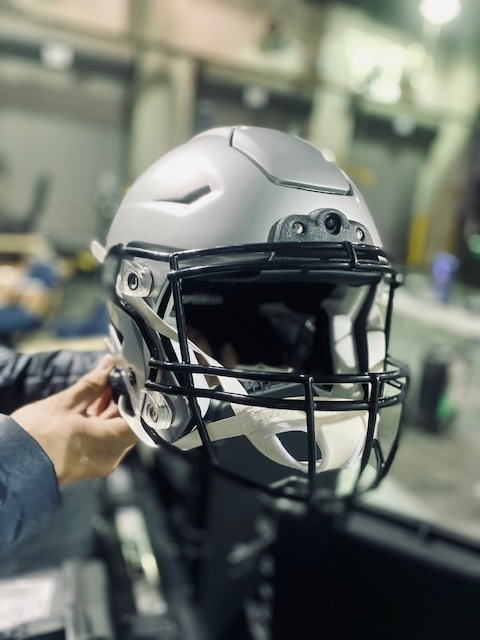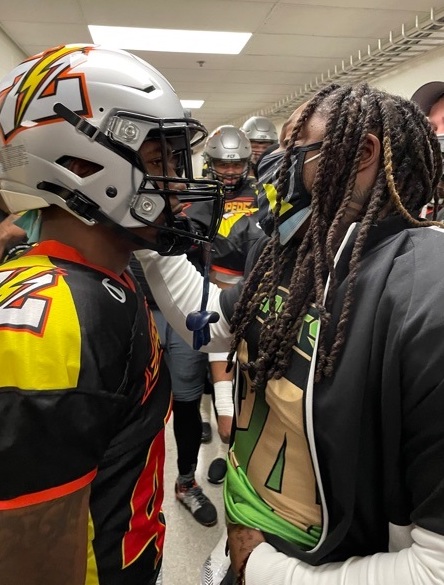In Inaugural Season, Fan Controlled Football Innovates on the Field, in the Broadcast
Productions deploy drones, HelmetCams, miked players, 180-degree cameras
Story Highlights
Fan Controlled Football (FCF) wrapped up its inaugural season over the weekend with The People’s Championship, marking the culmination of one of the more intriguing experiments in pro-sports history. In addition to being the only pro sports league to let fans call plays in real time, FCF, aided by production partner Crazy Legs Productions, aims to create a unique experience for viewers with non-traditional elements, including drones, HelmetCams, miked quarterbacks, and 180-degree cameras on the sidelines.
CLICK HERE for Fan Controlled Football’s Patrick Dees on ‘Redefining Football for the Digital Age’
“Our goal is to fundamentally redefine football for the digital age,” says FCF Co-Founder and Chief Gaming Office Patrick Dees. “We wanted to take a step back and ask, ‘If you invented football now, what would it look like?’”
How It Works: New League, New Rules
The first six-week season of Fan Controlled Football featured four-teams competing in 7-on-7 games for which fans made key decisions ranging from play-calling to roster moves. Teams switched players on a weekly basis, with each team retaining two franchise players selected by team owners and one selected by the fans after the first game. Each week, players not retained entered a pool for the redraft the following Wednesday. Games were played at Infinite Energy Arena outside Atlanta the next weekend.
Played on a 50-yard field with each team starting on its own 10-yard line, FCF games have two 20-minute halves (games take roughly an hour on average), with a running clock that stops after scores and for the one-minute warning at the end of each half (in the final minute, the clock stops following first downs or an incompletion).
There are no kickoffs, punts, or field goals. Extra points (either a 1-point conversion from the 5-yard line or a 2-point conversion from the 10-yard line) are determined by a 1-on-1 wide-receiver/defensive-back battle, for which fans choose the WR and DB and the QB has three seconds to throw the ball.
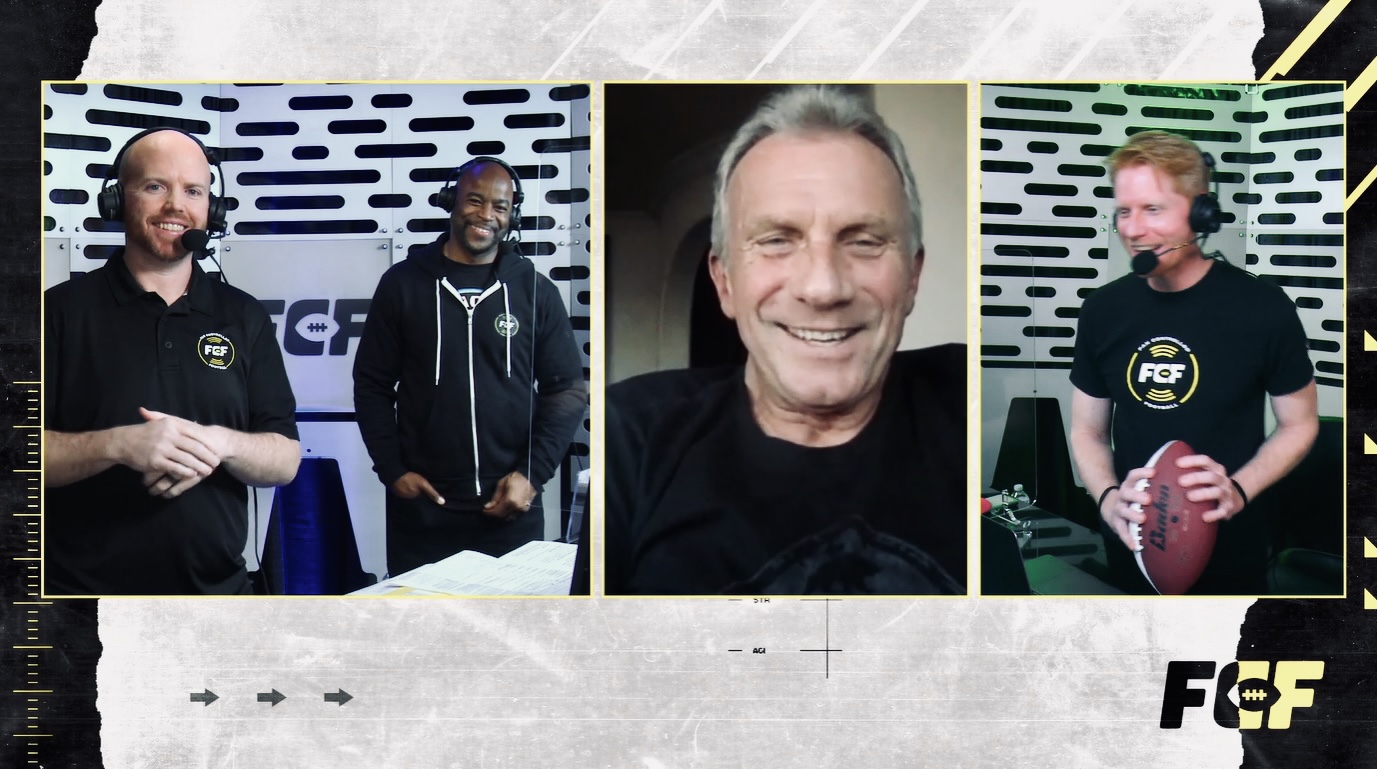
NFL Hall of Famer Joe Montana (center) is one of several guests who joined FCF broadcasts this year.
The FCF’s goal is to attract football fans and non-football fans alike with an emphasis on appealing to the gaming/esports community and younger generations of fans who grew up with EA’s Madden NFL videogame franchise. With Twitch and VENN as FCF’s primary distribution outlet, fans could interact with the content and provide real-time feedback in addition to selecting plays. The People’s Championship was carried by NBCLX and by DAZN Canada. VENN carried games all season, including the championship.
The league’s efforts apparently paid off. FCF became the fastest-growing live-sports channel on Twitch and the No. 2 most-watched live-sports channel (more than 7.5 million total live views on Twitch prior to The People’s Championship).
A Whole New Way To Cover Football
Crazy Legs Productions rolled out Ross Production Services’ RMP-6 mobile unit for the full six-week schedule. Inside the truck, the crew handled the broadcast, Twitch integration, and ActionStreamer HelmetCam operations.
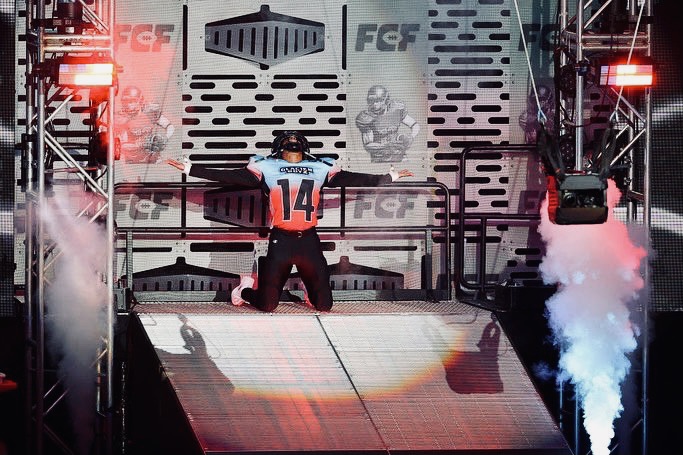
FCF’s bombastic entrances for player introductions give players a chance to showcase their personality.
FCF deployed DJI drones similarly to a Skycam to create the Madden videogame look. Originally, the production team had planned to use the drone as the primary game camera, but the nearly constant QB scrambling and big plays forced it to adjust.
“We really liked that Madden look, [similar to the] Skycam angle, where the drone snuggles down into the huddle and, when they break, you pull back and go over the shoulder of the quarterback,” says CJ Bottitta, who served as executive producer for the FCF broadcasts. “But one of the challenges with that is, when they throw it down the field as often as they do in this league, it’s hard to follow that ball. And the fans are loving having them throw the ball downfield.
“Another challenge,” Bottitta continues, “is that having quarterbacks who can scramble this much makes it really hard for the drone to [adjust]. We still use the main drone a lot, but we will continue to tinker with how we cover the live game play.”
In addition to the drones, the camera complement comprised one hard up camera at midfield, two hards at the 15-yard lines, two handhelds (one an RF), two or three HelmetCams per team on key players (typically QBs, WRs, and some strategic defenders), a HatCam POV system on the referee, and POV cams in the two commentator booths. Quarterbacks and key players are also miked during the games.
“The camera positions have evolved because we’re truly learning a whole new sport,” says Bottitta. “Yes, it’s football, but it’s 7-on-7, and the wrinkles that are involved in this sport — the point after, kickoffs, review challenges, power-ups — mean you need to learn the actual sport almost from scratch. With the tighter field, sometimes it’s like producing in a Thomas’s English muffin: you have little nooks and crannies that you have to find the best angle for and adjust how you would normally do things.”
Because the game is played on a 50-yard field, the production team could use shorter lenses than in a traditional football broadcast. For example, the midfield game camera had a 60mm lens, the midfield cameras at the 15-yard lines were 40mm, the RF 14mm, and the wired handheld a 22mm.
“The main idea behind the broadcast is that it’s the linear layer that becomes the base for all the fan interaction sitting in the extension overlay and the mobile app,” says producer/director William Chapman, who worked the FCF broadcasts. “FCF fans participate by calling the plays via the Twitch extension or mobile app. This translates into the broadcast graphics and game analysis.”
In terms of safety protocols, all production crew members were required to wear masks at all times, socially distance, and refrain from contact with players, officials, and other on-field personnel.
All About Access: HelmetCams, Miked Players, Hot Mic Booth
At any given time, two players (sometimes three) per team wore HelmetCams provided by ActionStreamer. The angles from these feeds were cut into the broadcast live, used on replays, and available as iso feeds for fans to watch via the Twitch Command Center.
“Another unique piece of the league,” says Bottitta, “is that the backup quarterbacks play in a minimum of every third series and sometimes more often than that. We had HelmetCams not only for the starting quarterback, but we also needed them for backup quarterbacks and sometimes others as well.”
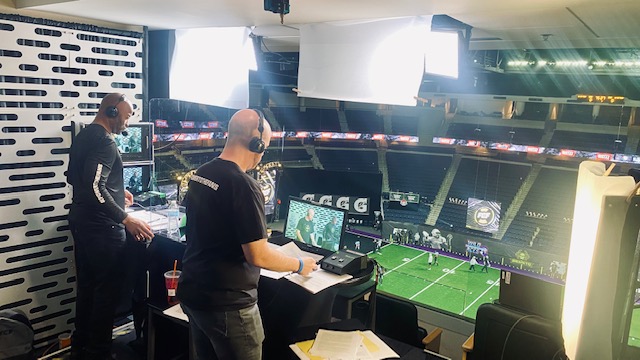
Play-by-play caller Greg Mescall (left) and analyst/commissioner/co-founder Ray Austin in the main announce booth at Infinite Energy Arena
Quarterbacks and other key players were also outfitted with microphones during the game to capture on-field audio. The QB’s mic was live in the huddle, according to Bottitta, who would cut it before the team was set at the line of scrimmage.
“There’s not as much discussion in the huddle,” he points out. “When the play comes in from the fans, it’s done. And there’s really not much time from when the play comes in to when you need to snap the ball. But we still were able to get some great audio from those mics in the huddle.”
Broadcasts also featured a Wendy’s Hot Mic Booth behind each end zone. Originally developed as a replay-based confessional-booth element, the Hot Mic Booth quickly mutated into a celebration cam used live in the broadcast.
“When a team scores or the defense makes a big play, everyone runs down there and celebrates in front of the camera,” says Bottitta. “The confessional booth was originally slated to go straight to tape and then [be run] as a replay; that camera wasn’t even on our switcher. But, very quickly, we had to pivot because we realized these guys are running in there immediately to celebrate and decided to go live with it.”
FCF Command Center: VR Experience, Iso Feeds, True Interactivity
According to Dees, one of the FCF’s key philosophies from the beginning has been to create “a broadcast that lived on Twitch and gave people a lean-forward experience.” This lean-forward experience became a reality in the FCF Command Center on Twitch, allowing fans not only to vote on play selection but also to view a variety of camera angles, interact with the content, provide live feedback.
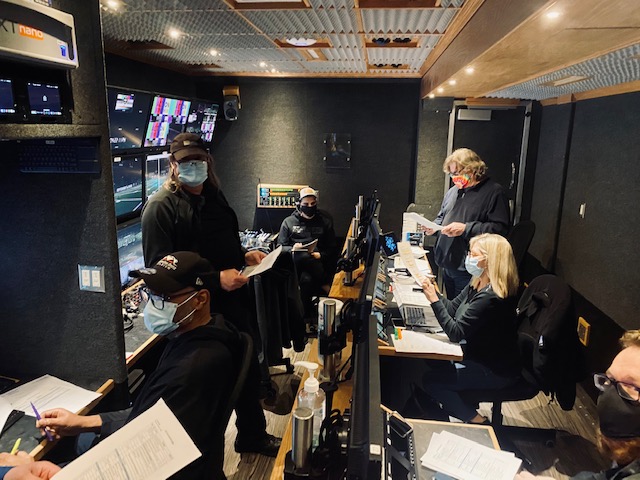
Ross Production Services RMP-6 served as the home of FCF game productions, which were handled by Crazy Legs Productions.
In addition, four 180-degree VR cameras at the end zones and on the sidelines could be viewed via the FCF Command Center. YBVR handled this side of the production, as well as a separate OTT multiviewer, using a flypack onsite. The VR camera systems were not part of the truck workflow (YBVR operated separately), but Bottitta says the production team will explore integrating them into the broadcast in Season 2.
“It’s all fan-driven so we try to be reactive to the [Twitch] chat as it’s happening,” says Bottitta. “One of the key performance indicators is delivering exactly what the fans want. We know it’s not a traditional broadcast and will continue to evolve, so we have leaned into the Twitch aspect. We embrace the edginess of it all, and that was something that FCF encouraged us to do early on. We think we’ve created something unlike anything [football fans] have ever seen.”
Dual Announce Booths Add New Dimension
FCF broadcast featured two separate announce booths at Infinite Energy Arena. Play-by-Play Caller Greg Mescall and Analyst/Commissioner/Co-Founder Ray Austin were located in a large suite (larger than a traditional broadcast booth to allow social distancing). A second booth housed guests (including NFL legend and FCF Chief Strategy Officer Joe Montana, NFL star and Co-Owner of the Glacier Boyz Richard Sherman, and Kinda Funny Manager and Co-Owner of the Wild Aces Greg Miller), who were frequently integrated into the production. In addition, Dees joined the broadcast periodically as a third announcer.
“That second announce booth added a whole new element that was really exciting,” says Bottitta. “Patrick is our chat guy; he’s our fan proxy. He brings in not only the chat from Twitch but, as a founder, adds a lot of insight in terms of the rules.”
Season 2 and Beyond: Updates and Evolution
With Season 1 in the books, Dees and company are looking ahead to Season 2. He likens the league’s evolution to software, with the season just completed being version 1.0 and next season and beyond getting a massive update. Bottitta echoes the same sentiment for future FCF broadcasts.
“My Season 2 wish list is already pretty long because, when you’re experimenting, you work in theory and then you get to reality and it’s totally different,” says Bottitta. “One of the challenges of a six-week season is, there’s really not much time to pivot once you’ve locked something in. Some things can pivot pretty quickly, but other things are going to have to wait for Season 2. We’re all very excited about what’s going to be possible in Season 2.”
